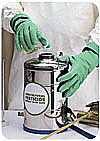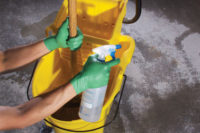
The workplace can be a fast-moving environment. All too often, workers are ill-prepared for workplace safety — especially when it comes to wearing the proper hand protection. Employers and employees should be educated on what types of gloves offer the best protection for the environment and applications in which they work. Workers should also know how to properly use and maintain gloves to ensure the highest level of protection.
One of the most common mistakes made in hand protection programs is the lack of any safety program at all. The U.S. Department of Disease Control and Prevention reports that among the 3.8 million work-related injuries that occur each year, the majority involve the hands and fingers. Wearing the wrong protective equipment, especially gloves, not only fails to properly protect, but can lead to serious injury. Companies and their employees cannot afford the financial or lost productivity costs that are associated with work-related injuries.
Workers are frequently faced with a very limited understanding of why hand protection is needed or even how to protect themselves. The wrong glove is often paired with the wrong job, causing even greater danger. There are simple and effective ways to prevent such work-related injuries. Knowing which type of glove works will greatly increase worker safety and productivity.
Which glove is right?
It is imperative that employers and employees know which gloves are suitable for their tasks. Correct specification is important both to remain in compliance with regulations and to protect workers from injury. Innovations in materials and technology have resulted in an ever-increasing selection of products for just about any purpose imaginable. But with such a wide variety of choices, which glove is the right glove for the job?In the manufacturing environment, hand injuries generally result from physical or chemical hazards. With the correct general or special purpose gloves, many injuries are largely preventable. Gloves manufactured from advanced fibers and polymers provide superior protection from cuts and lacerations as compared to cotton, leather or standard synthetic yarn gloves. Additional protection can be provided through various coatings applied to the glove.
Gloves that offer protection against chemicals are vital in protecting the user against dermatitis, chemical exposure or burns and other hazards, especially when harmful chemical substances can enter the body. These substances can come in the form of liquids, dusts, vapors, gases or even fibers when produced in a process.
When chemical-resistant gloves are needed, be sure to carefully evaluate each glove individually; the specification should be based on the type of job for which the glove will be used. For chemical mixtures or jobs where multiple hazards are present, it is necessary to wear gloves that have the highest chemical resistance. A resource based on glove testing should be used to select the correct chemical-resistant glove. One such source, designed by Best Manufacturing Co. —www.chemrest.com— provides information on glove testing and chemical resistance.
It is important to remember that no single glove will protect against all applications or substances. All gloves can potentially leak — none offer 100 percent protection. By choosing the right material and construction, gloves can and will give ample protection.
Glove lingo
To create the safest working environment possible, educate all employees on the basics of PPE and on the specific glove that they use. Vital information that every user should know and understand when purchasing, wearing and disposing of their gloves includes:Permeation — Permeation occurs when substances pass through the intact material of the glove at the molecular level. Permeation is also known as the “silent killer.â€
Penetration — Penetration occurs when a substance passes through a seam or damaged part of the glove, such as a pinhole or tear.
Degradation — Degradation occurs when a substance damages the material of the glove, making it less resistant. The end result is the physical breakdown of the polymer.
Contamination — Contamination occurs when the inside of the glove becomes contaminated throughout the wrist opening and gauntlet, most likely due to poor donning/doffing practices.
Glove fit & fitness
Sometimes, the wrong glove is worse than no glove at all. Workers must read the MSDS on the glove. And size does matter. Proper sizes must be made available. Tasks cannot be safely performed on the job with ill-fitting gloves.A key to remember is that all gloves need to be changed on a regular basis to avoid glove failure. No glove will last longer than a few days, and cleaning certain types of gloves is not always possible. Decontamination or laundering of gloves must be practical and effective. A change-out schedule is an easy and efficient way to ensure gloves will hold up. Many glove manufacturers offer advice on how long gloves will last, but it is difficult to determine the life of each individual glove. Inspect gloves each time they are used; replace them immediately if any damage is found. The most effective way to detect damage is to slightly inflate the glove with compressed air and check for air leaks by holding the glove under water and looking for bubbles.
It is often necessary to change the way a company and its workers view safety procedures. Both employer and employee need to take the initiative to learn about proper hand protection. By developing a mindset or culture in the workplace to emphasize a “safety first†environment, injuries can be avoided.


